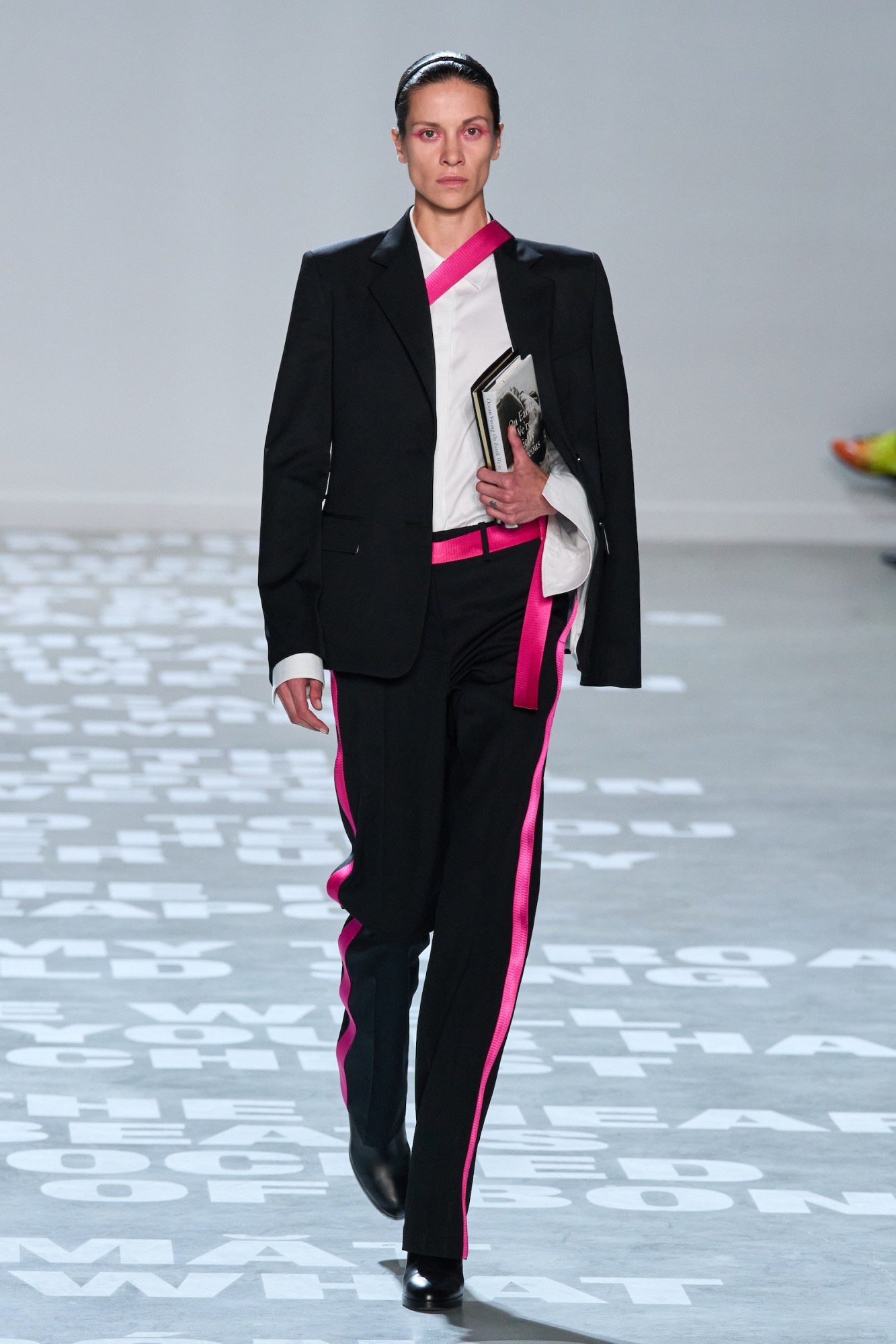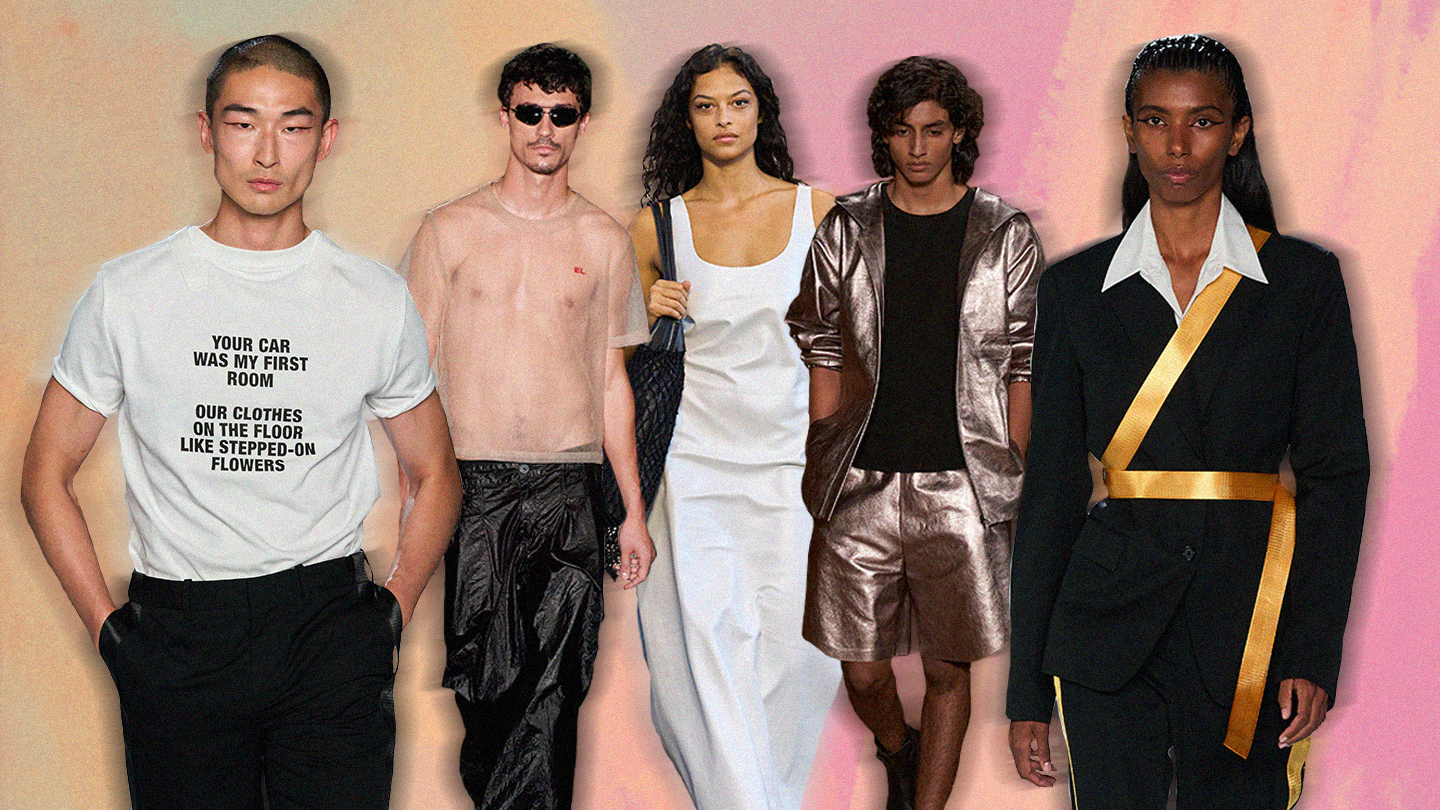There’s a spectre haunting New York, and it’s wearing Helmut Lang. Aside from the newly announced Peter Do’s rendition of what Helmut Lang sans Lang should look like, the SS24 season has so far been marked with a cool, stripped-back minimalism reminiscent of the brand’s 90s-to-noughties heyday. From Gabriela Hearst and Proenza Schouler to Eckhaus Latta, tropes from the Austrian designer-turned-artist have — perhaps in a strange case of hive-mind mentality – appeared in strappy, undie-outie looks, resplendent in monochrome.
In fact, Langisms have been everywhere since the eighties when the designer’s subconscious hold on the industry first set in. “Without [Raf] Simons’s template of slim tailoring and street casting, there would not have been a Hedi Slimane — just as there would never have been a Raf Simons without Helmut Lang,” Cathy Horyn once wrote. “Fashion develops a bit like a genetic line.”

Indeed, if the tanks and jeans of Matthieu Blazy’s Bottega Veneta or the sleek lines of Phoebe Philo’s Celine ever felt familiar, it’s because they are. So, too, are the atypical models that have defined Demna’s Balenciaga. Friends and freaks, old and young, Helmut enlisted whoever he wished for shows and shoots, levelling them with sparingly used supermodels. The same goes for campaigns. JW Anderson has been spotlighting his fine art taste in coded but considered nods – Anthea Hamilton sculptures shot by David Sims for AW22, for example – throughout his career, just as Helmut had spotlit the likes of Louise Bourgeois in licensed portraits from the Robert Mapplethorpe estate. At one point, he insisted on advertising in National Geographic, citing its democratic appeal as his rationale. Fashion was always normy in Helmut’s eyes.
Of course, this is not to call it plagiarism, but instead a remark on Helmut’s enduring legacy on Planet Mode despite departing his namesake label almost two decades ago. His schtick was making the quotidian extraordinary, so it’s little wonder we’re noticing him more when the new word on everyone’s lips is reduction. Look closely, and you’ll notice a shift that’s been underway for some time. Painter’s jeans are now a high-street mainstay, while the SS98 bulletproof vest has become a bona fide uniform among rappers. Besides, who doesn’t have their label plastered across a taxi in this day and age? Helmut did that first, too.

No doubt, our ears are especially pricked to Lang’s indelible mark now that Peter Do, a major Helmut acolyte, has been plumbing the inventory. Naturally, he’s kept it stripped back with only a few choice charges of colour in the form of seat-belt bondage straps, a nod to Helmut’s sash designs of SS97. As such, we’re quickly reminded of the undercover subversions that made Lang a legend and eternally relevant.
It’s endemic. For further proof of the Helmut Lang effect, look to Jack McCollough and Lazaro Hernandez’s latest Proenza Schouler offering, which kept its palette almost entirely black and white, layering tank tops, shoulderless dresses and skirts with sheer or string-vests outers. Waists were wrapped with walletted belts and Velcro military bum bags akin to Helmut’s ballistic vest, while nip slips were present, but so smoothly integrated under the gauzy fabric they felt pedestrian. As for the ostrich feathers adorning one slinky long-sleeve, this could have been transplanted straight from Lang’s SS99 or SS20 collections, when the bird’s silky plumes added flourish to an otherwise restrained collection.

In practice, it’s angelic, if not ethereal. The same could be said of the chrome track jacket and shorts over at Fforme or Gabriela Hearst’s icy, scoop-neck apron dress. These are the clothes moviemakers use to represent heaven – pure and tranquil and a far cry from the Y2K kitsch that’s perpetrated our feeds and runways in the past few years. In many ways, it’s a welcome shift. Ours is a time of social and political deadlock. The cozzie livs is going nowhere, and camping it up in high-gloss, Barbie-core pinks and low-waisted jeans doesn’t feel right to many.
Fortunately, fashion can offer a balm – at least superficially. If postmodernism is the logic of late capitalism, it makes sense that a return to order and modernist purity offers a way out. Lang’s less-is-more approach is the clinical, white-cube essentialism we’ve been pining for.
That’s not to say it can’t be sexy, though. Throughout his career, Helmut evidenced that the simple and low-fi can be just as hot as excess. His SS04 Juergen Teller campaigns were a case in point, using modest fabrication – a cut-out hem across the nipple or clean, metallic skirts – to foreground sensuality. In many ways, it’s a method gleaned from his idol, Robert Mapplethorpe, whose untitled layered underpants and jockstrap artworks were used as part of Helmut’s jeans campaigns during the late nineties, highlighting the sheer sex appeal of cloth layered upon cloth.
Eckhaus Latta’s latest show, complete with rustling, black tarpaulin trousers and transparent nude separates, confirms this further. Rather than fantasising in the fantastic plastic of noughties trash, it presents us with something rawer or daresay rudimentary, salvaging the functional and bringing its texture and form into sharp focus. Steamy, we know.
Elsewhere, we’ve seen Helmut’s calculated use of typography return to the runways, notably at Valentino’s SS24 menswear show, which printed crisp Langian shirting or black and white suits with excerpts from Hanya Yanagihara’s A Little Life. Notably, Peter Do himself took a similar root to Helmut, applying poet of the moment Ocean Vuong’s poetic words to white office shirts and rolled-up t-shirts just as Helmut had once done with artist Jenny Holzer in his own campaigns. Again, a movement towards the sublime minimalism, cutting through the noise of today with a sincere, artistic proposition.
Return to reduction 2.0 or trashion fatigue – whatever you call it, the move to a cooler, consistent and humbler fashion, like Helmut Lang’s original days, has taken hold. Given that so much of his archive perished when his studio caught fire in 2010, it’s a testament to his influence, and undoubtedly a smart response to the times we’re in. Helmut Lang didn’t delineate between fashion and life, and life right now is serious. Serious clothes make sense.

